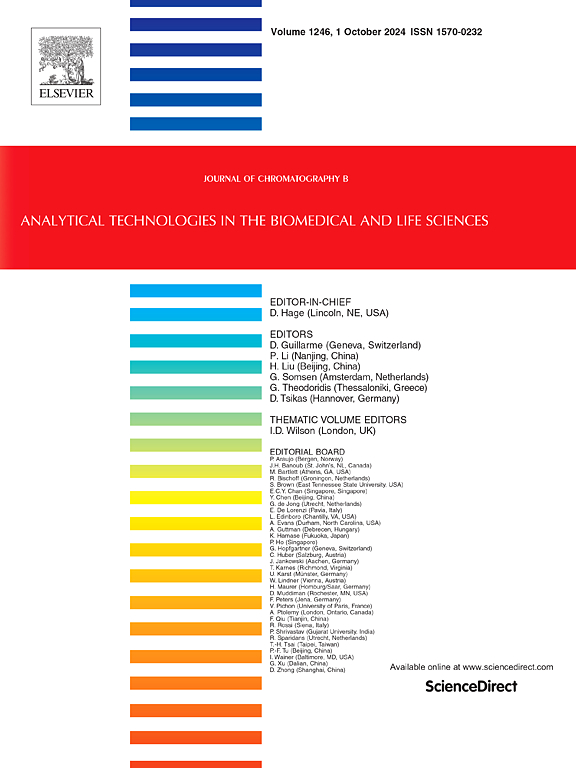在非对称双特异性抗体的纯化过程中,用MabSelect VH3去除同型二聚体
IF 2.8
3区 医学
Q2 BIOCHEMICAL RESEARCH METHODS
引用次数: 0
摘要
双特异性抗体在制造过程中不断产生副产物,其中同型二聚体是最关键的杂质。有效去除同型二聚体是必不可少的,因为它们的存在会损害产品纯度,并可能对治疗安全性和有效性产生不利影响。亲和层析技术利用了靶抗体和固定配体之间高度选择性的分子相互作用,是单克隆抗体(mAbs)和双特异性抗体(bsAbs)纯化的金标准技术。在这项研究中,我们使用三种市售的具有不同结合位点的蛋白A树脂:MabSelect PrismA, MabSelect SuRe LX和MabSelect VH3来评估同型二聚体的分离效率。本研究的双特异性抗体(bsAbs)和同型二聚体的Fc和VH3区与亲和树脂的结合能力不同。对比分析表明,完全依赖于VH3结构域相互作用的MabSelect VH3获得了最高的分离性能,最终产品纯度超过98.9%。与MabSelect SuRe LX的单Fc结合机制相比,MabSelect PrismA的双结合(Fc和VH3)相互作用降低了分离效率。此外,在bsAb和同源二聚体之间的Fc结合和VH3结构域差异下,差异的Fc亲和力被确定为影响分辨率的主要因素。这些发现为bsAb生产的下游工艺优化提供了有价值的见解,强调了基于分子相互作用机制的战略性树脂选择的重要性。本文章由计算机程序翻译,如有差异,请以英文原文为准。
Removal of homodimer species with MabSelect VH3 during the purification of an asymmetric bispecific antibody
By-products are continuously generated during the manufacturing process of bispecific antibodies, among which homodimers represent the most critical impurity. The effective removal of homodimers is essential, as their presence compromises product purity and may adversely affect therapeutic safety and efficacy. Affinity chromatography, which exploits the highly selective molecular interactions between target antibodies and immobilized ligands, remains the gold-standard purification technique for monoclonal (mAbs) and bispecific antibodies (bsAbs). In this study, we evaluated the separation efficiency of homodimers using three commercially available Protein A resins with distinct binding sites: MabSelect PrismA, MabSelect SuRe LX, and MabSelect VH3. Both the Fc and VH3 regions of the bispecific antibodies (bsAbs) and homodimers in this study have different binding capacities to the affinity resin. Comparative analysis revealed that MabSelect VH3, which relies exclusively on VH3 domain interactions, achieved the highest separation performance with final product purity exceeding 98.9 %. In contrast to MabSelect SuRe LX's single Fc-binding mechanism, separation efficiency was compromised by MabSelect PrismA's dual-binding (Fc and VH3) interactions. Additionally, the differential Fc affinities were identified as the dominant factor influencing resolution under concurrent Fc-binding and VH3 domain disparities between the bsAb and homodimer. These findings provide valuable insights for downstream process optimization in bsAb production, emphasizing the importance of strategic resin selection based on molecular interaction mechanisms.
求助全文
通过发布文献求助,成功后即可免费获取论文全文。
去求助
来源期刊

Journal of Chromatography B
医学-分析化学
CiteScore
5.60
自引率
3.30%
发文量
306
审稿时长
44 days
期刊介绍:
The Journal of Chromatography B publishes papers on developments in separation science relevant to biology and biomedical research including both fundamental advances and applications. Analytical techniques which may be considered include the various facets of chromatography, electrophoresis and related methods, affinity and immunoaffinity-based methodologies, hyphenated and other multi-dimensional techniques, and microanalytical approaches. The journal also considers articles reporting developments in sample preparation, detection techniques including mass spectrometry, and data handling and analysis.
Developments related to preparative separations for the isolation and purification of components of biological systems may be published, including chromatographic and electrophoretic methods, affinity separations, field flow fractionation and other preparative approaches.
Applications to the analysis of biological systems and samples will be considered when the analytical science contains a significant element of novelty, e.g. a new approach to the separation of a compound, novel combination of analytical techniques, or significantly improved analytical performance.
 求助内容:
求助内容: 应助结果提醒方式:
应助结果提醒方式:


